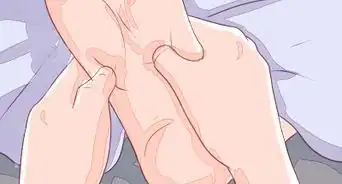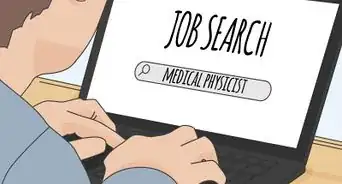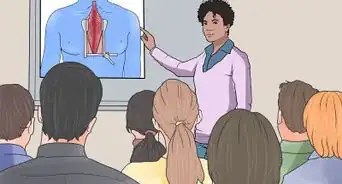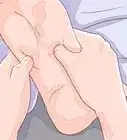wikiHow is a “wiki,” similar to Wikipedia, which means that many of our articles are co-written by multiple authors. To create this article, 16 people, some anonymous, worked to edit and improve it over time.
There are 12 references cited in this article, which can be found at the bottom of the page.
This article has been viewed 372,086 times.
Learn more...
Nutritionists are experts in food and nutrition. A qualified nutritionist advises people on what to eat in order to lead a healthy lifestyle, or how to achieve a specific health-related goal. According to the United States Bureau of Labor Statistics,[1] employment of nutritionists is expected to increase 20 percent from 2010 to 2020, faster than the average for all occupations. Here’s how to get started!
Steps
Starting Your Education
-
1Investigate the requirements needed by your state. There are 30 states that require a license and 15 states that require certification (1 requires registration after an accredited course). Generally, the requirements for state licensure and state certification include having a bachelor’s degree in food and nutrition or a related area, supervised practice, and passing an exam.
- If you’re curious, the 4 states that currently do not have any licensure requirements are Arizona, Colorado, Michigan and New Jersey.[2]
-
2Find an educational program. The accreditation required for a degree in the nutritional science field varies from state to state. Currently, 46 states require an accredited 2 or 4 year degree in nutritional science (either online or campus-based.) Getting your bachelor’s in nutrition, institution management, biology, chemistry, and physiology is your best bet.[3]
- You’ll also benefit from business, mathematics, psychology, sociology, and economics courses. Odds are, if your program is a good one, it will touch on all these bases. And if your state is one that requires a license with experience, it’s best to pick a program that has a built in internship.
Advertisement -
3Consider an advanced degree in nutritional science. An advanced degree isn’t strictly necessary, but a solid understanding of biology, chemistry and health will be a great asset. In addition, the more education you have, the more job opportunities you’ll have. If you’d like to continue learning, it's a good idea! [4]
- If you do complete an advanced degree, you are that much closer to getting certified through the CBNS (Certification Board for Nutrition Specialists). If you take and pass the exam, you will become a Certified Nutrition Specialist. However, this article will outline becoming a Certified Clinical Nutritionist -- a process that doesn’t need an advanced degree.
Getting Certified
-
1Complete the CNCB's coursework requirements. Before you go any further, you need to have the right coursework under your belt.[5] The CNBC (Clinical Nutrition Certification Board) requires three hours in each of the following: anatomy and physiology, chemistry, microbiology, human biology and biochemistry. Hopefully your undergrad covered that!
- You can also choose 5 of 8 electives; they are: Introduction to Nutrition, Nutrition and Disease, Nutrition Assessment, Nutrition Counseling Strategies, Nutrition II, Nutrition and Supplementation, Herbology and Nutrition and Aging.
-
2Get through all the paperwork. In order to get on your merry certified way, you'll need to submit your credential review application and college transcripts to the CNCB. Then you should obtain credential approval from the board and begin your PGSCN course, eventually taking the CCN exam.[6]
-
3Take the PGSCN. It's four courses long (14 hours each) and done online -- the only downside is that each course is $1,125. You have 90 days to complete the 4 sessions and they can be done in any order.
- If you do not have a sufficient amount of applicable coursework to your name, you can still get a Certificate of Completion by taking the 56-hour PGSCN. This, though similarly named, holds less weight than getting certified and does not qualify you to take the CCN -- you need the coursework to do that.
-
4Take the CCN exam. Now that you've taken all the courses, the PGSCN, and submitted all your paperwork, you're good to apply to sit for the CNN. It's taken at a testing facility and is 3 hours long.
- The CCN is $450 currently, but the study guide is available online for free! Quite clearly, these are tests you don't want to have to take twice. [7]
- You're done -- once you've passed the CCN exam, you're good to go!
Working as a Certified Nutritionist
-
1Apply for state licensure. The procedure for obtaining a license is similar in most states; you gather the documentation you need, get them notarized and submit the application and fee. Find the licensure requirements for your state by visiting the website of the Commission on Dieticians and Nutritionists.
- If you are ever thinking about moving (or practicing with a long commute), consider getting licensed in another state as well. Unfortunately, just because you're licensed in one does not mean you're licensed in another.
-
2Seek and obtain employment. As stated before, nutritionists have a plethora of options when it comes to places of employment. You can work in many settings, including hospitals, cafeterias, nursing homes, government agencies and schools. Some are even self-employed![8]
- Nutritionists aren't just advice givers. Though plenty work with patients much like doctors do, they're also government employees and researchers, too. However, the more "scientific" your position, the more education you'll need.
-
3Consider specializing. As a nutritionist, you could concentrate on any number of topics.[9] Geriatric care, raising children, care of those with diabetes or other illnesses, etc. However, it's also determined by your environment -- maybe you don't want to work one-on-one at all? Generally speaking, your duties could include some of the following:
- Working with patients, looking at a their blood chemistry, neurochemistry and other indicators to assess how they are metabolizing food. You will also identify imbalances caused by poor or inadequate nutrition that contribute to disease.
- Some nutritionists work for government regulatory agencies, ensuring that the manufacturer’s nutritional claims about the amount of calories, sodium and vitamins in processed foods correct.
- Research! The realm of research when it comes to food and nutrition is still growing and will continue to do so. Working at an educational institution will put you on this path, improving how the world views food.
-
4Be prepared to participate in on-the-job training. Most nutritionists have to participate in several hundred hours of supervised training. Some degree programs include this hands-on training, but you may have to complete this portion after you graduate in the form of an internship in a medical setting.
- After this experience and if you've completed the CCN, you may qualify as an RD -- a registered dietician. The qualifications are parallel to those states that require licensure.[10]
Having the Right Stuff
-
1Develop a bedside manner. Nutritionists have to listen to patients to understand their concerns and their goals. Your medical expertise aside, you will also function as a cheerleader and empathetic listener.[11] Some of your patients may struggle with the program you have outlined; you should be prepared to help them overcome any hurdles they encounter. They're depending on you for their health, after all.
- Part of a nutritionist’s job is to assess a patient’s energy level through personal interviews and tests, and give the patient nutritional advice. As such, you will be spending a lot of face-to-face time with your patients. An in-depth assessment using a holistic approach will mean you’ll have to know more about your patient than his or her eating habits; you’ll need to learn about your patient’s lifestyle and goals, their personal problems and fears, their childhood eating habits, and their cultural and taste preferences.
-
2Work on your analytical skills. You will have to keep up with the latest developments in nutrition research and be able to interpret scientific studies.[12] Not everyone has the background you do, so you'll need to translate the statistical data into practical applications for your patients.
- There are new research studies every week about the effects, good and bad, of various foods. These studies are often contradictory. As a trained nutritionist, you will be expected to interpret conflicting health research studies to develop a healthy, sound plan of action for your patients.
-
3Get organized. As a nutritionist, you will have many patients, each with different backgrounds and needs. You will need to keep your files organized and easily accessible. And you'll need to remember their names, their families, and their personalities!
- Even though this job is very science-oriented, it's very people oriented, too. In order to keep your clients on, they'll need to feel as if they are your only client. If you can't remember them from Joe, you're outta luck (and money!).
- If you are self-employed, this goes double. You'll be handling your own taxes, licenses, and be working as a "company." When April 15th rolls around, you'll be glad you're as organized as you are.
-
4Learn how to effectively communicate. You will often have to explain complicated topics in a way that your patients will understand. Simply telling patients that certain foods are good for them is not enough; you should be able to explain the technical aspects of your prescribed nutritional programs.[13]
- Think of yourself as the bridge between science and your patients -- you need to be able to people-speak and science-speak! After all, the Internet can tell them what to eat and not eat, what to do and what to avoid -- it's you who has to put the personal, doable twist on what can be a very daunting subject.
Warnings
- The position of ‘Nutritionist’ is not a specifically registered or certified title, as opposed to the term ‘Dietitian’ or ‘Registered Dietitian’, approved only by the American Dietetic Association’s Commission for Dietetic Registration (CDR). The term ‘Nutritionist’ is not limited to individuals who have attained only the specific qualifications specified by the CDR, but is instead given to a variety of nutrition professionals with a vast number of different skills and approaches to health.[14]⧼thumbs_response⧽
References
- ↑ http://www.bls.gov/ooh/Healthcare/Dietitians-and-nutritionists.htm
- ↑ http://cdrnet.org/vault/2459/web/files/Licensurelawsregulations.pdf
- ↑ https://www.canr.msu.edu/fshn/undergraduate_programs/dietetics/dietetics_requirements
- ↑ https://www.eatrightpro.org/practice/professional-development/advanced-degrees
- ↑ https://www.cncb.org/#:~:text=The%20CCN%20Examination%20Candidate%20must%3A&text=Submit%20Credential%20Review%20Application%20and,on%20the%20online%20CCN%20Examination
- ↑ http://www.cncb.org/
- ↑ https://www.cncb.org/wp-content/uploads/sites/2699/2021/07/2021-CCNExamCandidateHandbook-Chisholp-Place.pdf
- ↑ http://www.bls.gov/ooh/Healthcare/Dietitians-and-nutritionists.htm
- ↑ https://www.wur.nl/en/Education-Programmes/master/MSc-programmes/Nutrition-and-Health/Specialisations-of-Nutrition-and-Health.htm
- ↑ http://www.bls.gov/ooh/Healthcare/Dietitians-and-nutritionists.htm#tab-4
- ↑ https://www.careerride.com/view/nutrition-dietetics-specializations-and-skills-required-10706.aspx
- ↑ ttps://www.careerride.com/view/nutrition-dietetics-specializations-and-skills-required-10706.aspx
- ↑ https://www.careerride.com/view/nutrition-dietetics-specializations-and-skills-required-10706.aspx
- ↑ https://www.nutritioned.org/dietitian-vs-nutritionist.html
About This Article
To become a nutritionist, practice motivating people in your life and helping them with their problems since nutritionists often work with patients who need a lot of support and encouragement. Also, take classes that are science and research-based, which are things that you'll deal with a lot as a nutritionist. It's also a good idea to work on your communication skills since you'll need to explain complicated topics in a way that your patients will understand. To learn how to get certified as a nutritionist, read on!










































































Medical Disclaimer
The content of this article is not intended to be a substitute for professional medical advice, examination, diagnosis, or treatment. You should always contact your doctor or other qualified healthcare professional before starting, changing, or stopping any kind of health treatment.
Read More...